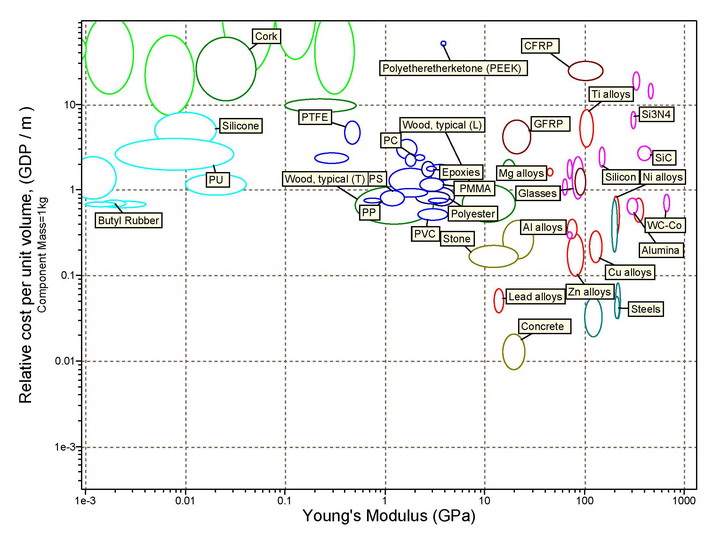11.6: Comparison of Engineering Materials and Biomaterials
- Page ID
- 8239
Sometimes it is important to look at more than one materials-selection map and merit index. For instance on comparison of the use of steel and aluminium as a material for aircraft, the merit index \(\frac{\sigma_f}{\rho}\) for loading a tie in tension shows that steel outperforms aluminium in this context. (Of course, as shown on the maps, both steels and aluminium alloys are families of materials with broad ranges of properties.) In fact, steel wires were used by the Wright brothers and in World War I biplanes:

However aluminium performs well under the elastic bending of beams and flat panels, having a greater value than steel for the merit indices \(\frac{E^{1/2}}{\rho}\) and \(\frac{E^{1/3}}{\rho}\) and hence aluminium alloys are now used to make major parts of aircraft whereas steel is not.
It may also be important for a material to have high values of more than one merit index. For example a material may be wanted that will be tough and also have a good value of Young’s modulus for a low relative cost per unit volume:

Consider a comparison of biomaterials to man-made materials, specifically commonly used engineering materials such as steel, aluminium alloys, titanium alloys, alumina and polyethylene. It can be seen that alumina, aluminium alloys, steel and titanium alloys perform quite well in terms of Young’s modulus – density related merit indices. This is due to their high values of Young’s modulus, despite their high densities. Polyethylene compares poorly with biomaterials in this respect however, due to its low value of Young’s modulus.
Alumina, aluminium alloys, steel and titanium alloys are more commonly used in engineering applications than biomaterials. This is despite biomaterials, particularly types of wood, outperforming these materials for some of the merit indices on this materials-selection map. It is important to note that the distinction between the materials of living systems and conventional engineering materials is not absolute. Wood is more widely used than these engineering materials for low-tech applications, and is in fact the world’s principal material for building. This makes wood among the most common and important structural engineering materials. Although wood has only a quarter the strength of steel, it has four times the specific strength \(\left ( \frac{\sigma_f}{\rho} \right )\) and is renewable, recyclable and requires only a low energy input to make. This makes the price of wood 1/60th per tonne the price of steel with 109 tonnes being used annually worldwide, which is comparable to the amount of iron and steel used globally. Wood has many uses such as the hubs and rims of traditional wheels (for which elm and oak, respectively, are used), longbows (made from yew) and cricket bats (made of willow). However wood is strongly anisotropic, highly susceptible to water damage and unable survive and to perform at high temperatures. There is also a large amount of variability in wood, as different growing conditions for trees of the same species lead to differing mechanical properties. It is possible to limit the anisotropy of wood by using plywood, which involves creating layers of wood with orthogonal “grains” (orientation of the tracheid/ fibre cell structure). The other limitations cannot so easily be overcome, limiting wood’s use as an engineering material with light specifications. (This is discussed in The Structure and Mechanical Behaviour of Wood teaching and learning package).

Looking at the strength – density materials selection chart:
Alumina clearly outperforms biomaterials when loading a tie under tension, it has a high value of the merit index \(\frac{\sigma_f}{\rho}\) and performs well for all merit indices shown on the above map. But the applicability of alumina is likely to be limited by its brittleness (low Kc) and the difficulty of forming into components. Aluminium alloys, titanium alloys, and particularly steel and polyethylene, have merit indices inferior to those of many biomaterials. This is due to their greater density and in polyethylene’s case relatively low strength. This doesn’t necessarily mean that biomaterials will be chosen over common engineering materials however. Other factors to be considered in choosing a material for an engineering application once merit indices have been compared include:
- cost
- resistance to creep
- ease of manufacture
- availability
- resistance to corrosion
- ability to function at a required temperature
- energy efficiency
Only when all these factors along with the merit indices and materials-selection maps have been considered, can the best material for a particular application be found. Materials-selection maps and merit indices can be used to compare broad ranges of different materials to discover roughly which few materials are most suitable. Each material would then need to be assessed in more detail to discover which material is truly best for a specific use.


